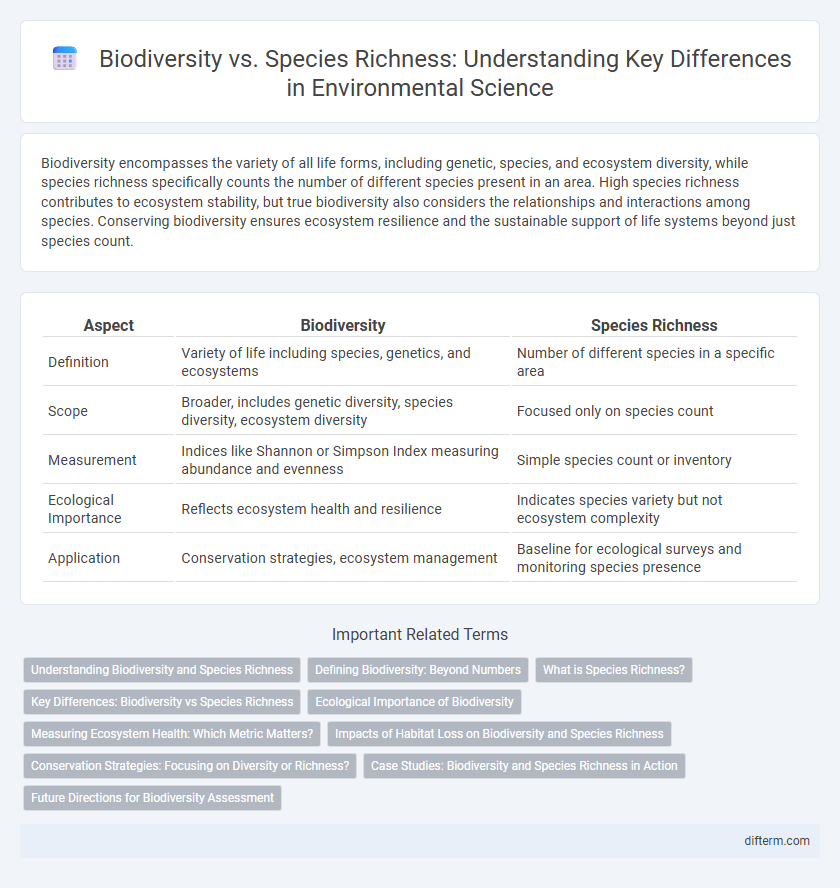Biodiversity encompasses the variety of all life forms, including genetic, species, and ecosystem diversity, while species richness specifically counts the number of different species present in an area. High species richness contributes to ecosystem stability, but true biodiversity also considers the relationships and interactions among species. Conserving biodiversity ensures ecosystem resilience and the sustainable support of life systems beyond just species count.
Table of Comparison
| Aspect | Biodiversity | Species Richness |
|---|---|---|
| Definition | Variety of life including species, genetics, and ecosystems | Number of different species in a specific area |
| Scope | Broader, includes genetic diversity, species diversity, ecosystem diversity | Focused only on species count |
| Measurement | Indices like Shannon or Simpson Index measuring abundance and evenness | Simple species count or inventory |
| Ecological Importance | Reflects ecosystem health and resilience | Indicates species variety but not ecosystem complexity |
| Application | Conservation strategies, ecosystem management | Baseline for ecological surveys and monitoring species presence |
Understanding Biodiversity and Species Richness
Biodiversity encompasses the variety of all life forms, including genetic, species, and ecosystem diversity, reflecting the complexity and interdependence of natural systems. Species richness specifically measures the number of different species present in a given area, serving as a fundamental indicator of biodiversity but not capturing genetic variation or ecosystem diversity. Understanding the distinction between biodiversity and species richness is crucial for effective conservation strategies and maintaining ecosystem resilience.
Defining Biodiversity: Beyond Numbers
Biodiversity encompasses the variety of life at genetic, species, and ecosystem levels, highlighting ecological interactions and functional roles beyond mere species richness. Species richness measures the number of species in an area, but biodiversity includes species abundance, genetic variation, and ecosystem diversity, which collectively sustain resilience and ecosystem services. Understanding biodiversity requires integrating complexity and interdependence within habitats rather than focusing solely on species counts.
What is Species Richness?
Species richness refers to the total number of different species present in a specific ecosystem or area, serving as a fundamental measure of biodiversity. It quantifies species diversity by counting how many unique species inhabit a habitat, without considering their relative abundance or distribution. Monitoring species richness helps scientists assess ecosystem health and resilience, guiding conservation efforts to protect biological variety.
Key Differences: Biodiversity vs Species Richness
Biodiversity encompasses the variety of all life forms within an ecosystem, including species richness, genetic diversity, and ecosystem diversity, while species richness specifically refers to the count of different species present in an area. Biodiversity provides a broader measure of ecological complexity and resilience, reflecting interactions among species and their genetic variations. Understanding these key differences is crucial for effective environmental conservation and management strategies.
Ecological Importance of Biodiversity
Biodiversity encompasses the variety of life forms, including genetic, species, and ecosystem diversity, which ensures ecosystem resilience and stability. Species richness, a component of biodiversity, refers specifically to the number of different species in a given area but does not account for the relative abundance or ecological roles of these species. High biodiversity supports essential ecological functions such as nutrient cycling, pollination, and climate regulation, which maintain ecosystems' health and productivity.
Measuring Ecosystem Health: Which Metric Matters?
Biodiversity encompasses the variety of genes, species, and ecosystems within a region, offering a comprehensive indicator of ecosystem health beyond mere species richness, which counts the total number of species. Measuring ecosystem health requires evaluating species richness alongside species evenness, genetic diversity, and functional traits to capture the complexity and resilience of ecological communities. High biodiversity contributes to ecosystem stability, productivity, and adaptability, making it a more robust metric for assessing environmental sustainability compared to species richness alone.
Impacts of Habitat Loss on Biodiversity and Species Richness
Habitat loss directly reduces biodiversity by eliminating the complex interactions between species and ecosystems, leading to declines in species richness as numerous organisms lose their native environments. The fragmentation and destruction of habitats disrupt ecological networks, causing population declines and local extinctions that diminish genetic diversity and ecosystem resilience. This reduction in species richness compromises ecosystem services such as pollination, nutrient cycling, and climate regulation, exacerbating environmental instability.
Conservation Strategies: Focusing on Diversity or Richness?
Conservation strategies that emphasize biodiversity prioritize the variety of life forms, genetic variations, and ecosystem functions, ensuring resilient ecosystems capable of adapting to environmental changes. Species richness, representing the total number of species in an area, serves as a useful but limited metric that may overlook the ecological roles and interactions critical for ecosystem stability. Effective conservation balances protecting species richness with maintaining genetic diversity and habitat complexity to support long-term ecosystem health and resilience.
Case Studies: Biodiversity and Species Richness in Action
Case studies from the Amazon rainforest reveal that biodiversity encompasses the genetic, species, and ecosystem variety, whereas species richness specifically measures the number of different species in a given area. Research in coral reef ecosystems demonstrates that high species richness often correlates with greater resilience and ecological stability, emphasizing the importance of preserving both metrics for sustainable conservation efforts. Studies in African savannas highlight that areas with high biodiversity support complex food webs and ecosystem services critical for human well-being and environmental health.
Future Directions for Biodiversity Assessment
Future directions for biodiversity assessment emphasize integrating advanced genetic tools such as environmental DNA (eDNA) with traditional species richness surveys to capture hidden or cryptic species diversities effectively. Incorporating remote sensing technologies and artificial intelligence enables large-scale, real-time monitoring of ecosystems, improving accuracy in detecting biodiversity changes over time. Emphasizing functional and phylogenetic diversity alongside species richness provides a more comprehensive understanding of ecosystem resilience and guides targeted conservation strategies.
biodiversity vs species richness Infographic

 difterm.com
difterm.com